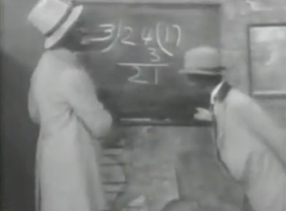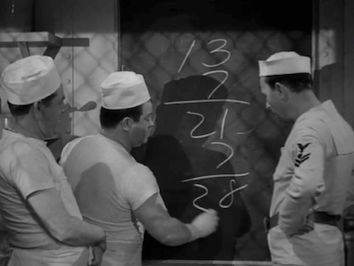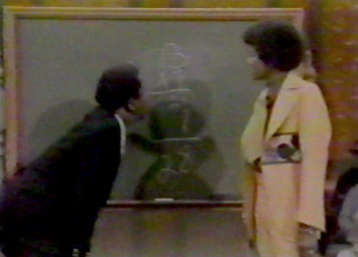Movies, mathematics and mulsification
by Burkard Polster and Marty Ross
The Age, 8 October 2012

You might have occasionally wondered about what goes into creating our columns. If so, you'll be reassured to know that your maths masters' work is simple and relaxing. We always finish our projects with plenty of time to spare, leaving many leisurely hours to while away. Life is easy.
Well, no. That last paragraph was pure fantasy.
However, we do occasionally get a break and, like many other people, given a free evening we enjoy relaxing with a movie. Then, unlike many other people, we make sure to look for the maths. And that's how a whole new project is born.
Ten years ago your maths masters began to collect movies containing mathematics. We didn't think it would be a big deal: grab A Beautiful Mind and a few others, and that'd be it. However, 800+ movies and TV shows later, there's still no end in sight.
Our book on maths in the movies has just appeared. It contains chapters devoted to major movies such as A Beautiful Mind and Pi, as well as chapters on specific mathematical topics, funny bits, bloopers and so on. The book is intended to be fun rather than scholarly.
Fun or not, the book wasn't always fun to write. Yes, we got to watch a lot of movies. But sad to say, many of the movies were incredibly dull. Mathematicians are often included in movies because of their image as being other-worldly, and the mathematics is intended to be symbolic. Unfortunately, all that symbolism tends to come across as tedious and trite.
A typically dreary example is Agora, the 2009 movie about the famous Greek mathematician Hypatia. Hers is a tragic and fascinating, if significantly mythical, story. However, and notwithstanding the opinions of some "top" film critics, Agora is poorly written, plodding and preachy. And, the little maths it contains is pretty silly.
But we can't really complain. There were many excellent movies to document and many rare and unexpected gems to discover. A (growing) collection of our favourite maths movie clips can be found here.
Many wonderful mathematical moments appear in movies that have nothing at all to do with maths. Perhaps the best and most famous is the Abbott and Costello arithmetic skit (YouTube).

Appearing in their 1941 movie In the Navy, Lou Costello attempts to convince Bud Abbott that 7 × 13 = 28. His three "proofs", by division, multiplication and addition, are hilarious perversions of school arithmetic. As the screenshot above indicates, the proofs all turn on the abuse of positional notation for numbers (the second 7 is in the wrong position).
Abbott and Costello performed this skit on at least three other occasions, and many other teams performed it as well. Perhaps most well-known (though not particularly funny) is the version by Ma and Pa Kettle (YouTube) in Back on the Farm, where they prove 5 × 14 = 25. Most surprising is the version by a very young Michael Jackson (YouTube), together with (the largely forgotten but funny) Flip Wilson.

There are a number of other versions as well, and we decided to hunt for the origin of this terrific skit. We failed.
Almost certainly the earliest filmed version of the skit appears in the incredibly obscure 1928 short Jimtown Speakeasy (You Tube). In that excellent version, the African American team of Flournoy Miller and Aubrey Lyles prove that 3 × 17 = 24, both by"mulsifying" and "reviding". (See the screenshot at the beginning of this column.)
The best guess is that Miller and Lyles created the skit. They wrote the book for and appeared in the groundbreaking African American musical Shuffle Along, and a number of authorities claim that the skit appeared in the original production, in 1921. If so, it is likely that the skit originated in the Miller and Lyles routines of the preceding years.
However, we have not been able to find any direct evidence that Shuffle Along contained the skit, and there is some evidence that it did not. The skit is not contained in the script, though that is not unusual for such comedy bits. However, none of the critical reviews of the 1921 production that we have located mention the skit. Moreover, it seems that working copies of the skit from the 1921 production contain no evidence of the skit.
So, who is responsible for the wonderful "Abbott and Costello" skit? Miller and Lyles is as good a guess as any, but it seems unlikely that we'll ever know for sure. Still, it was a very enjoyable hunt. Your maths masters' work may seldom be relaxed, but it is often a hell of a lot of fun.
Puzzle to Ponder: The film clips above prove that 7 × 13 = 28, 5 × 14 = 25 and 3 × 17 = 24. How many other such multiplications can you prove?
Free Public Lecture, Sunday October 14: Burkard will give a presentation entitled Hollywood Maths. See Burkard at the Melbourne Museum, 10:30-11:30. For more information and to register, please visit the MAV website.
Burkard Polster teaches mathematics at Monash and is the university's resident mathemagician, mathematical juggler, origami expert, bubble-master, shoelace charmer, and Count von Count impersonator.
Marty Ross is a mathematical nomad. His hobby is smashing calculators with a hammer.
Copyright 2004-∞ ![]() All rights reserved.
All rights reserved.